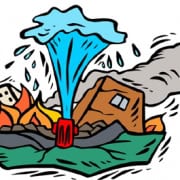Preparation Basics: Why Prepare and What to Do
The difference between an emergency and a disaster is that in an emergency, you can call 911 and somebody will come
- When the wildfire comes, you get what protection the crews on the ground can give you, but you can’t ask for any more — and that may not be enough.
- When the power grid goes down, there’s nothing you can do to make it come back any faster, or to get electricity before anybody else does.
- And when the earthquake happens, the State tells us to expect to be without electricity, gas, and water for weeks, and that emergency and medical services will be crippled. [Note — earthquake link to be revised into a “Hazards” section]
All of those have happened, and will happen again. You need to decide in advance whether or not you want to be a survivor, because if you don’t make that choice and act on it, you have effectively chosen to be a victim.
RVM has emergency plans, equipment, supplies, and dedicated employees — but it is a retirement community, not a response, rescue and relief organization. There are major limitations on what support and protection we can expect if something really bad happens.
WHAT YOU NEED TO BE PREPARED TO DO
- Self-evacuate. If you have access to a vehicle and can drive, you can leave RVM. That is your decision, and your responsibility for doing so safely. For preparation advice, see the section on Cars in How to Prepare.
IMPORTANT CAUTIONS:
1.1 In any emergency or disaster, roads will be congested, traffic control or direction may be non-existent, and driving conditions poor (weather, smoke, darkness, damaged roads). If there is doubt about your driving skills or stamina, stay home. Should there be doubt? Test this checklist.
1.2 In any regional power outage, or if there is high demand or social disorder, it will be difficult or impossible to refuel. If you can’t get much farther than you think you need to go with the fuel in your car, stay home. - Shelter in place — Apartments
2.1 Have at least 3 days worth of ready-to-eat food, water, and basic household supplies readily available –and more if possible. Even if RVM is able to meet basic needs, confusion and staff shortages will interfere with distribution and support. See How to Prepare.
2.2 Be prepared to function without electricity in your apartment. Emergency power will probably be available in the hallways, but that is not absolutely guaranteed. Elevator access may be affected.
2.3 In the event of an earthquake, you will probably be without running water — causing problems with sanitation as well as eating and drinking.
2.4 Cooling or heating may be limited or unavailable.
3. Shelter in place — Cottages
3.1 Emergencies other than wildfires
3.1.1 Stock two weeks worth of nonperishable food, water, household supplies and needed equipment (See How to Prepare), or as much of that amount as is practical.
3.1.2 Be prepared to be without electricity, gas, running water and sewage disposal — this means no cooling, heating, and extremely limited washing
3.2 Wildfire evacuations — Shelter at RVM
3.2.1 In the event that a wildfire evacuation (Level 3) Alert is issued by the civil authorities, residents may self-evacuate (see above) or shelter in the high-rise buildings.
3.2.2 Evacuation to a high-rise shelter is very different from self-evacuation off-site: Transportation is provided by RVM, the amount of material you need to — and can — take with you is more limited, specific preparations for pets must be made, etc. See the fire evacuation instructions and How to Prepare.
Prepare for Disaster at Two Levels — the personal and the community level. You live or die at the personal level — but the community can have a major influence on which outcome happens.
For all situations — know the RVM procedures, your RPG Coordinators, and your neighbors.
ACCESS TO RESOURCES
WHAT YOU NEED TO BE PREPARED FOR
HOW TO PREPARE
ACCESS TO RESOURCES
Resident Resources — the Resident Preparedness Group (RPG) is a volunteer organization that strives to support RVM preparedness efforts by ensuring that every Independent Living resident is within a short walk of a volunteer with a commitment to emergency preparation and response. These are the Neighborhood (in the cottages) or Floor (in the towers) Coordinators. To learn about the RPG and identify your Coordinator, go to RPG — Activities and Organization. Then meet him or her, and become part of the preparedness network. The network is everybody — you and your neighbors. The better you know each other, the better your common preparation will be.
RVM Resources —
Information resources —
UNDER CONSTUCTION — TENTATIVE OUTLINE
Potential responses
FAQs
Ability to respond effectively
[With links down- or off-page to expanded articles, and ultimately (2nd order) to the How to]




Leave a Reply
Want to join the discussion?Feel free to contribute!